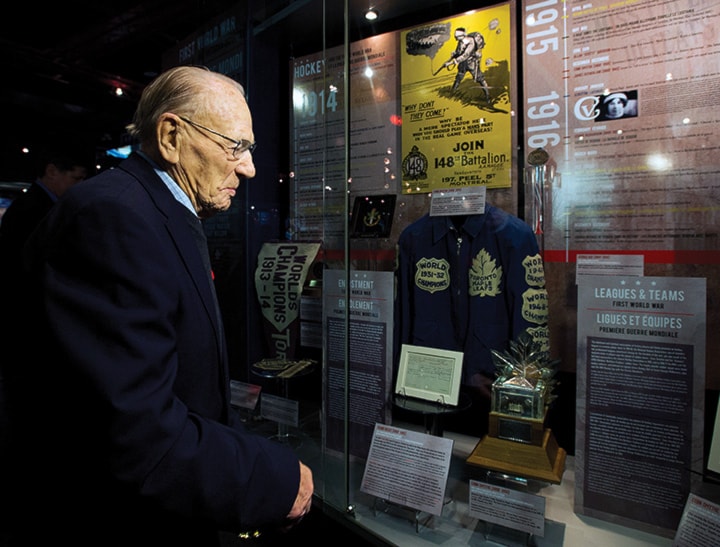TORONTO — Hall of Fame goalie Johnny Bower lied about his age to enlist for the Second World War. He was just 16.
“They wanted to see my birth certificate and I said ’We had a big fire at home.’ And I said it was burned,” Bower recalled Monday with a healthy belly laugh. “I lied there just so I could get in.”
“I wanted to go with my other buddies,” he added.
Years later, the ugly truth of war remains with the former Maple Leafs great, who turned 90 on Saturday. Many of those friends didn’t come back.
“I was lucky, very lucky to be back here,” said Bower, the laugh suddenly gone.
The sacrifice of those and other hockey players is captured in a new Hockey Hall of Fame exhibit called “Hockey Marching As To War” which was unveiled Monday on the eve of Remembrance Day.
The Hall says 40 of its inductees were First World War veterans, with another 31 serving in the Second World War.
Some of those names live on via NHL and other trophies: Jack Adams, Conn Smythe, Frank Selke and Hobey Baker.
The Memorial Cup, the symbol of junior hockey supremacy, was conceived as a way to honour young men who traded their hockey stick for a rifle and paid the ultimate price.
Capt. James T. Sutherland, president of the Canadian Amateur Hockey Association, used the Cup to honour Allan (Scotty) Davidson and George Richardson whom he coached when they were Kingston Frontenacs. Both died in action in the First World War.
The Hall of Fame exhibit showcases a quote from Sutherland:
“With every man doing his bit, Canada will raise an army of brains and brawn from our hockey enthusiasts the likes of which the world has never seen. The bell has rung. Let every man play the game of his life.”
Sutherland was inducted into the Hall of Fame as builder in 1945.
The list of Hall of Fame veterans is a Who’s Who of hockey, featuring the likes of Bower, Sid Abel, Syl Apps, Bobby Bauer, Max Bentley, Turk Broda, Roy Conacher, Hap Day, Doug Harvey, Punch Imlach, Tommy Ivan, Lynn Patrick, Bud Poile, Milt Schmidt, Tiny Thompson and Harry Watson, to name a few.
In a country where hockey rules, the sport took a backseat to the fight for freedom. As former Maple Leaf Ron Ellis, a consultant to the Hockey Hall of Fame noted, entire leagues folded as men enlisted for the First World War.
Ellis’s father Randy was playing for the Toronto Marlies when the Second World War broke out. He enlisted at 18, trading the hockey rink for a pilot’s cockpit.
Gordie Howe was just 15 for his first NHL training camp, in 1943 with the New York Rangers. With players away at war, NHL teams were scouring for talent.
“They went and fought for their country, like we all did,” Bower said.
At five foot nine, Bower cuts a relatively small figure. But like so many who volunteered to put themselves in harm’s way, it is impossible to measure the size of his heart.
The teenage Bower spent two years in Vernon, B.C., before being stationed in England for a year. Rheumatoid arthritis eventually prevented then-Private Bower him from going to the front.
“It’s a good thing I didn’t because the Germans were right there, just waiting,” he said. “A lot of guys there were killed on the beaches. I know four or five good hockey players from Prince Albert (his hometown) were killed.”
“Sure, it was scary,” he added. “You wanted to go home, back to your family and your wife if you were married. I was hoping that nothing would happen to me if I did see action. But that’s the chance you take when you’re fighting for your country.”
Red Kelly, a Hall of Fame player who went on to serve in Parliament, was a teenager working on a farm to help supply troops during the Second World War. Later on, he saw the Korean war up close during a 1954 visit to the troops.
He still recalls seeing the barbed wire and the hills that men died to take.
“You’d win one hill and then you’d face another hill just like it, right behind it,” he said.
Kelly lists off players who put their career on hold to fight for their country.
“They served to save their country, what more can you say?” said the 87-year-old Kelly. “Some of them gave up their lives. They can’t come back. But we have to think what they did for us.”
